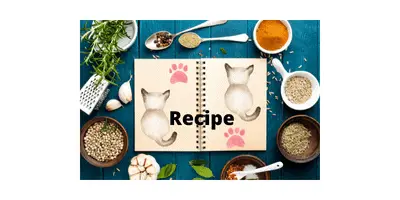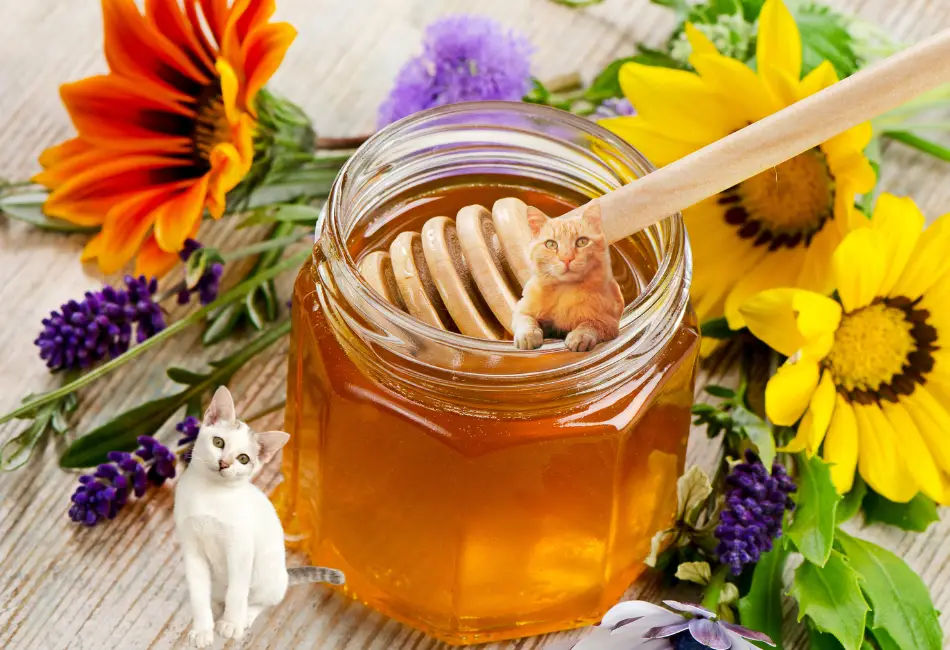There aren’t too many foods that you can either eat or wear, but honey is one of them. Not only is it nutritious, but it also has many medicinal effects whether eaten or applied to injured skin. That goes for humans as well as many animals. Can cats have honey?
A cat is neither a person nor a Pooh but small amounts of honey can be good, and we’re going to tell you how! Our goal is to help you learn about honest cat care that works.
Honey with a Grain of Salt
Asking, “Can cats have honey?” is only half the question. The other half is, “HOW can cats have honey?” Feline digestion differs from that of omnivores such as dogs and humans. Omnivores can get their nutritional needs met from both plant and animal sources.
Cats, on the other hand, are obligate carnivores, meaning that they’re obligated to consume an animal-based diet or they’ll starve. Sugars, found most abundantly in plants, aren’t easily digested and can cause upset stomachs, vomiting, and diarrhea. Senior cats with age-related changes frequently experience difficulties with certain foods.
Diabetes and obesity are ever-present risks. Young kittens with undeveloped immune systems are especially susceptible to infection by toxin-producing bacterial colonies growing from spores in their tiny intestines.
Talk to a trusted holistic veterinarian before introducing your pets to new foods, especially if the pets are very young, pregnant, very old, or otherwise vulnerable. If you don’t have a regular vet who’s open-minded and familiar with your animals, consider finding an office practicing integrative veterinary care which integrates the best of modern medicine with alternative methods. A natural holistic approach addresses each patient in terms of age, gender, general health, and personality.
What Makes Honey Special?
Honey is unique, made only by a few bee species. Comparable to an insect equivalent of mother’s milk, honey nourishes the growing young with needed nutrients as well as provides anti-inflammatory, antioxidant, and antibacterial support. Scientists are actively researching its many beneficial properties.
See our related post: Do Bees Eat Honey? The Birds AND The Bees Eat Honey!
Can Cats EAT Honey?
That might sound like a simple question but it’s not. Did you know that cats can’t taste sweetness? Since plants most often contain the molecules triggering sweetness in certain taste sensors, obligate carnivores have little need for them. Humans have 9,000 taste buds, dogs have 1,700, and cats have only 470. None for detecting sweetness.
If you’ve noticed your feline buddy enjoying honey, it’s likely because of other overriding scents and tastes. Maybe the dog is gobbling up some honey, or maybe your cat is CURIOUS! You know how that works!
Can Cats Have Manuka Honey? Is Manuka Honey Safe for Cats?
Manuka honey is pretty potent stuff. It’s made from flowers of the Manuka bush, a hardy evergreen plant native to Australia and New Zealand. It’s known to contain high concentrations of substances with healing properties. It definitely has antibacterial abilities.
Tests on rodents indicate potential benefits for stomach ulcers, indigestion, gum disease, tumor growth, and as a dressing for skin and wound conditions. More research needs to be done, especially on cats, but Manuka honey offers hope. In small amounts, it’s quite safe.
Benefits of Honey for Cats
There are more than 300 kinds of honey, but they all contain the following:
- Vitamins
- Minerals
- Antioxidants
- Amino acids
- Anti-inflammatory properties
- Anti-bacterial properties
Honey is being researched to treat the following medical conditions:
- Cardiovascular problems: May reduce inflammation leading to cardiac disease.
- Cough: Not only a throat-soothing syrup, but honey may also function as a cough suppressant promoting undisturbed sleep.
- Diarrhea: May ease loose stools from gastroenteritis.
- Infections: Taken orally or used as a wound dressing especially on burns, honey supports healing.
- Neurological issues: Some evidence exists that honey helps reduce depression, anxiety, memory disorders, and seizure activity.
- Rehydration: Can aid in recovery from dehydration.
Can cats have honey? A little, yes. Its traditional medicinal and veterinary uses are sure to increase with time.
Diet: The Foundation of Health for Cats & How Food Is Medicinal
Although food is often regarded in our society as recreation, in truth FOOD IS MEDICINE. The entire purpose of food in biology is to fuel growth and repair. The sense of taste evolved to guide critters to eat more of some substances and less of others.
The importance of the study of ecology is maintaining balance in the food chain with a diversity of life so nothing goes to waste. Diversity implies different kinds of nutritional needs. Felines in the wild have been successful for millions of years because they prevent the overpopulation of prey animals by consuming them. Given freedom of choice, animals crave what they need most.
What Is the Best Diet for Cats?
Cats are obligate carnivores. They must have animal flesh to survive. You can’t be squeamish watching cats eat natural food because their preferred diet is based on instinct. In a perfect world, pets would be able to enjoy all the benefits of a BARF-type diet: Biologically Appropriate Raw Food. “Biologically appropriate” refers to the specific needs of felines in the right proportions, including muscle meat from mammals, birds, and fish.
Additional essentials include brains, eyes, stomach with contents, lungs, liver, spleen, kidneys, uterus with contents, testicles, eggs, fat, ground bone or small raw bones, the works. “Raw” refers to being fresh, clean, unprocessed, and uncooked, preferably from humane local sources. “Food” encompasses supplements such as the essential amino acid taurine, small amounts of plant material such as grasses and herbs in the right proportion, and enough variation to prevent boredom.

In a less-than-perfect world, barriers prevent consistency and might result in indigestion or malnutrition. One alternative is giving pre-made BARF foods from reputable specialists. Another alternative is offering BARF supplements to improve what your cat has been eating. Finally, evaluating your pets’ present kibble and canned food ensures high-quality and minimally processed nutrition.
Transitioning From Kibble To RAW
Transitioning: Cats accustomed to dry kibble may not immediately accept a raw diet because they’re conditioned to carbohydrates as an energy source. Unfortunately, carbs are not nutrient-dense, meaning that they contribute empty calories. Try new foods gradually to give your pets’ digestive systems time to adapt.
Water: Water is an essential nutrient. In the wild, cats gain water from their food, but pets don’t live in the wild. You can meet their water requirements by placing several clean bowls in sheltered spots away from the litter boxes. Many cats enjoy running water, so investing in a kitty fountain will make drinking more fun. Since water supplies vary greatly in their purity, investing in a undercounter reverse osmosis system is an investment in the health of everyone in your cat’s household.
Can Cats Have Raw Honey?
Raw honey is not only uncooked but also unprocessed in its most natural form. This means that it contains the most active enzymes and nutrients in their most powerful form. Same rule applies to cats and raw honey . . . . . a small amount is most like medicinal for them but their carnivorous diet doesn’t require it.
Is Honey Good for Cats?
This is an exciting time in the history of honey. Scientists and doctors all over the world are researching honey’s potential to support the health of people and pets. Can cats have honey? Until confirmed evidence is available, remember Vitamin M: MODERATION. In fact, we have a couple of recipes for cat treats below. Can cats EAT honey? Try these and find out!
Homemade Treats for Cats

Manuka Honey DIY Treats For Cats
INGREDIENTS
- 1½ cups whole wheat flour
- ½ cup milk
- ½ teaspoon catnip
- 1 tablespoon Manuka honey
- 2 tablespoons melted butter
- 1 egg
DIRECTIONS:
- Preheat oven to 350F.
- Mix catnip and flour together in a medium bowl, forming a well in the center.
- In another bowl, mix Manuka honey, melted butter, and egg together.
- Pour honey mixture into flour mixture, combining to make a firm dough. If too sticky, add more flour.
- Roll dough to a 1/4-inch thickness and cut small shapes with a cookie cutter or the open end of a glass.
- Bake about 20 minutes or until golden brown.
- Cool. Store in vacuum-sealed container up to two weeks in refrigerator or up to three months in freezer.
- Note: Remember that these are quick kitty rewards, not a substitute for regular meals. Too many treats cause the blood sugar to spike.
Chewy Homemade Honey Cat Treats

INGREDIENTS
- 1 egg
- 4 ounces canned duck or chicken cat food
- 1 teaspoon raw honey
- 1/4 cup chopped parsley
- 2 teaspoon coconut oil
- 2 teaspoon water
- 1 cup brown rice flour
- 1/2 cup cooked brown rice
DIRECTIONS
- Preheat oven to 325F.
- Line baking sheet with parchment paper.
- Combine egg, cat food, parsley, olive oil, honey, and water in medium-size bowl.
- Whisk well.
- Add rice flour and cooked rice.
- Stir. Dough should be consistency of peanut butter, thick but spreadable.
- Spread onto baking sheet about 1/3 inch deep.
- Bake 12-15 minutes and remove from oven.
- When cool, cut into small bite-sized pieces (for the cat, not you!).
- Return to oven for 8 more minutes.
- Remove and cool.
- Store in fridge until gone (which won’t be very long!).
- Note: Since this tasty treat contains honey, discuss them with your vet. We additionally recommend feeding these in moderation.
SOURCE: https://manukahoneyusa.com/chewy-homemade-honey-cat-treats/
KEY TAKEAWAYS
- Cats don’t have the ability to taste sweetness.
- A small amount of honey including raw or Manuka honey is generally safe for cats. Honey, Manuka in particular, may provide health benefits as listed above.
- Don’t apply honey as a skin treatment on your own. Without proper training, you might introduce infection. Anyway, your kitty will probably lick it off right away, ingesting unneeded sugar.
- Food is medicine! A balanced diet of a variety of fresh, natural foods is more healthful than cheaply processed food with excess fat, sugar, salt, carbohydrate fillers, and additives such as dyes, preservatives, and flavor enhancers.
- Always consult your vet before giving a cat new foods, especially in the case of kittens, pregnant or nursing cats, the elderly, and pets with obesity, diabetes, and other conditions.
- Vitamin M for moderation! Begin slowly in small amounts and observe for problems.
- Keep reading Happy Tails for new information!
Vitamin O for Other Important Stuff
Along with a nutrient-dense diet, cats have other requirements. Good feline health involves every body system. Here are other basic needs:
- Mental stimulation: play, places to explore, challenges
- Companionship: bonding, interaction and communication with others who are familiar, not being isolated; contrary to the saying, cats are not independent souls
- Exercise: physical movement, opportunities to play, relieve frustration, and practice natural skills
- Outdoor time: windows and catios; you can take the cat out of the country but you can’t take the country out of the cat
Final Thoughts
Can cats have honey? Yes, in small quantities, but keep watching for research updates. As obligate carnivores, cats mostly prefer animal protein. What they honestly prefer from you is your caring friendship: Vitamin L for love! Now that’s sweetness they can’t get enough of.
Glossary
- Amino acid: One of the many building blocks of proteins
- Antioxidant: Any chemical compound that inhibits oxidation; in common use, it refers to natural compounds believed to prevent cells from degrading
- Botulism: A condition caused by ingesting the botulinum neurotoxin or the spores produced by Clostridium botulinum bacteria
- Ecology: The study of organisms, including humans, in their environment as they relate with each other
- Holistic: Treating the entire patient instead of focusing only on disease processes; including factors such as age, weight, general health, lifestyle, personality, and preferences
- Kibble: Dried processed meal formed into pellets composed of meat, plants, and additives
- Obligate carnivore: A living thing that must consume meat products for its main source of nutrition
- Reverse osmosis: The process of forcing water molecules through a filtering membrane that collects contaminants
- Pooh: A beloved fictional fuzzy yellow bear that talks to his animal friends and loves honey
- Sugars: Organized molecules of carbon, hydrogen, and oxygen (carbohydrates) that form chains and rings; since special enzymes or intestinal bacteria are needed to break down each kind into simpler forms, not all animals can digest all sugars
- Taurine: A specific amino acid necessary for many body functions; unlike many omnivores who synthesize taurine from other amino acids, cats need to get it from meat, fish, and eggs in their diet; deficiencies can cause blindness, heart problems, digestive disturbances, and poor development in kittens


